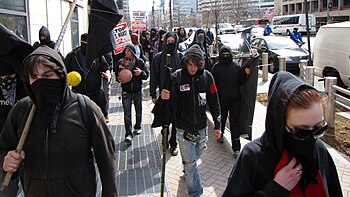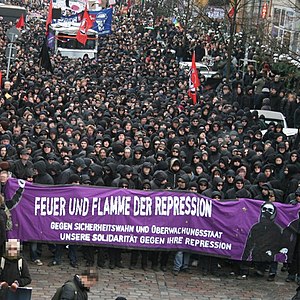Black bloc

A black bloc is a tactic for protests and marches, whereby individuals wear black clothing, scarfs, ski masks, motorcycle helmets with padding or other face-concealing items and often carry some sort of shields and truncheons.[1][2] The clothing is used to avoid being identified, and to, theoretically, appear as one large mass, promoting solidarity.
The tactic was developed in the 1980s by autonomists protesting squatter evictions, nuclear power and restrictions on abortion among other things.[1] Black blocs gained broader media attention outside Europe during the 1999 anti-WTO demonstrations, when a black bloc damaged property of GAP, Starbucks, Old Navy, and other multinational retail locations in downtown Seattle.[1]
"The Black Bloc" is sometimes incorrectly reported as being the name of a specific anarchist group. It is, rather, a tactic that may be adopted by groups of various motivations and methods.[3]
Tactics
This section needs additional citations for verification. (September 2010) |
Tactics of a black bloc can include vandalism, rioting and street fighting, demonstrating without a permit, misleading the authorities, assisting in the escape of people arrested by the police, administering first aid to persons affected by tear gas in areas where protesters are barred from entering, building barricades, and attacking police.[4][unreliable source?] Property destruction carried out by black blocs tends to have symbolic significance: common targets include banks, institutional buildings, outlets for multinational corporations, gasoline stations, and video-surveillance cameras.
There may be several black blocs within a particular protest, with different aims and tactics.[5] As an ad hoc group, they share no universally common set of principles or beliefs[5] apart from an adherence to–usually–radical left or autonomist values. A few radical right-wing groups, like some of the "autonomous nationalists" of Europe[6] or the Australian National-Anarchists[7] have adopted "black bloc" tactics and dress.
History
German origins
This section needs additional citations for verification. (February 2010) |

This tactic was developed following increased use of police force following the 1977 Brokdorf demonstration[8][9][10] by the German police in 1980, particularly aimed at anti-nuclear activists and squatters. Key areas for this development were Hafenstraße, Hamburg, and Kreuzberg, Berlin. These were social spaces occupied by dissidents who preferred to create their own social institutions based on communal living and alternative community centres. In June 1980, the German Police forcefully evicted the Free Republic of Wendland, an anti-nuclear protest camp in Gorleben, Wendland. This attack on 5,000 peaceful protesters led many former pacifists to become willing to use violent methods. By December 1980 the Berlin City Government organised an escalating cycle of mass arrests, followed by other local authorities across West Germany. The squatters resisted by opening new squats, as the old ones were evicted. Following the mass arrest of squatters in Freiburg, demonstrations were held in their support in many German cities. The day was dubbed Black Friday following a demonstration in Berlin at which between 15,000 to 20,000 people took to the streets and destroyed an expensive shopping area. The tactic of wearing identical black clothes and masks meant that the autonomen were better able to resist the police and elude identification. The German media labeled them der schwarze Block ("the black block"). In the Netherlands, similar militant resistance developed, but the wearing of ski-masks was less prevalent and the phrase Black Helmet Brigade was used.
In 1986 Hamburg squatters mobilised following attacks on Hafenstraße. A demonstration of 10,000 took to the streets surrounding at least 1,500 people in a black bloc. They carried a large banner saying "Build Revolutionary Dual Power!" At the end of the march, the black bloc then engaged in street fighting that forced the police to retreat. The next day 13 department stores in Hamburg were set alight, causing nearly $10 million in damage. Later that year, following the Chernobyl disaster, militant anti-nuclear activists used the tactic.
When Ronald Reagan came to Berlin in June 1987, he was met by around 50,000 demonstrators protesting against his Cold War policies. This included a black bloc of 3,000 people. A couple of months later, police intensified their harassment of the Hafenstraße squatters. In November 1987, the residents were joined by thousands of other Autonomen and fortified their squat, built barricades in the streets and defended themselves against the police for nearly 24 hours. After this the city authorities legalised the squatters residence.
When the World Bank and the International Monetary Fund met in Berlin in 1988, the autonomen hosted an international gathering of anti-capitalist activists. Numbering around 80,000, the protesters completely outnumbered the police. Officials tried to maintain control by banning all demonstrations and attacking public assemblies. Nevertheless, there were riots and upmarket shopping areas were destroyed.[11]
International development
The first recorded use of the tactic in United States of America was in 1989 at a protest at the Pentagon. Other early use in the US were the Earth Day Wall Street Action in 1990 and the February 1991 protests against the Gulf War. These were initiated by Love and Rage, a North American revolutionary anarchist organization active in New York. Black blocs gained significant media attention when a black bloc caused damage to property of GAP, Starbucks, Old Navy, and other retail locations in downtown Seattle during the 1999 anti-WTO demonstrations.[12] They were a common feature of subsequent anti-globalization protests.[13] During the 2010 G20 Summit in Toronto, a black bloc riot damaged an Urban Outfitters, American Apparel, Adidas Store, Starbucks and many banking establishments.[14][15]
Police infiltration
Police and security services have infiltrated black blocs with undercover officers. Since all members conceal their identities, it is harder to recognize infiltrators. Allegations first surfaced after several demonstrations. At the 2001 G8 summit in Genoa, amongst the many complaints about the police [16] there was mention of video footage in which "men in black were seen getting out of police vans near protest marches."[17] In August 2007, Quebec police admitted that "their officers disguised themselves as demonstrators." On these occasions, some were identified by genuine protesters because of their police-issue footwear.[18][19] But such recognition is difficult to make in video footage.[20]
See also
- 2010 G-20 Toronto summit protests
- Antifa
- Anti-globalization movement
- Anti-nuclear movement in Germany
- Rebecca Riots
- Union flying squad
- Zengakuren
References
- ^ a b c Autonomia and the Origin of the Black Bloc. Retrieved 7 November 2008.
- ^ Carlson, Kathryn Blaze (15 June 2010). "Black Bloc & Blue". National Post. Archived from the original on 15 June 2010. Retrieved 15 June 2010.
- ^ "Blackbloc Faq".
- ^ Battle of Genoa. Retrieved 16 November 2008.
- ^ a b K, 2001, "being black block" in On Fire: the battle of Genoa and the anti-capitalist movement, p. 31, One Off Press.
- ^ Nicola, Stefan (20 May 2008). "Germany's new neo-Nazis". UPI. Retrieved 28 June 2010.
- ^ Sunshine, Spencer (2008). "Rebranding Fascism: National Anarchists". Public Eye Magazine. 23. Retrieved 28 June 2010.
{{cite journal}}: Unknown parameter|month=ignored (help) - ^ http://www.topfoto.co.uk/gallery/Germany1963_1988/ppages/ppage37.html
- ^ http://www.topfoto.co.uk/gallery/Germany1963_1988/ppages/ppage39.html
- ^ http://www.topfoto.co.uk/gallery/Germany1963_1988/ppages/ppage40.html
- ^ A.G. Grauwacke. We Will Disrupt this Conference: Resistance to the 1988 IMF and World Bank Conference in West Berlin. In. Dissent Network! (eds). Days of Dissent: Reflections on Summit Mobilisations. http://www.daysofdissent.org.uk./berlin.htm translated from German as an extract from: A.G. Grauwacke. Autonome in Bewegung: aus der ersten 23 Jahren. Association A. (ISBN 3-935936-13-3).
- ^ http://www.seattleweekly.com/1999-12-22/news/delta-s-down-with-it.php
- ^ Fernandez, Luis A. (2008). Policing Dissent: Social Control and the Anti-globalization Movement. Rutgers University Press. p. 59.
- ^ By CBC.ca. "G20 protest brings violence, arrests - News - MSN CA". News.ca.msn.com. Retrieved 27 June 2010.
- ^ The Canadian Press (26 June 2010). "Violent Black Bloc tactics hit Toronto during G20 protest". Retrieved 28 June 2010.
- ^ FAIR. Media Advisory: Media Missing New Evidence About Genoa Violence. http://www.fair.org/activism/genoa-update.html
- ^ Carroll, Rory; John Vidal; David Pallister; Owen Bowcott (23 July 2001). "Men in black behind chaos: Hardliners plan 'actions' away from main protesters". The Guardian. Retrieved 28 June 2010.
- ^ "Quebec police admit they went undercover at Montebello protest". CBC News. 23 August 2007. Retrieved 28 June 2010.
- ^ Topping, David. "Bon Cop, Bad Cop". Torontoist.com. Retrieved 28 June 2010.
- ^ http://www.youtube.com/watch?v=yo0wMR-nc6Y&feature=related
Further reading
- A Communique On Tactics by the Green Mountain Anarchist Collective & Anti-Racist Action
- The Black Bloc Papers, by Xavier Massot & David Van Deusen
External links
